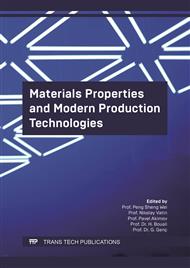[1]
Bobryshev, A.N., Erofeev, V.T., Kozomazov, V.N.: Physics and Synergetics of Dispersed-Disordered Condensed Composite Systems. p.476, Nauka, St. Petersburg (2012).
Google Scholar
[2]
Cherkasov, V.D., Tyuryakhin, A.S.: Theory of two-phase models of micromechanics of composites. p.108, Publishing house of Mordovian University, Saransk (2009).
Google Scholar
[3]
Khozin, V.G.: Strengthening of epoxy polymers. p.446, Publishing house of PIK House of the press,, Kazan (2004).
Google Scholar
[4]
Solomatov, V.I., Erofeev V.T., Smirnov, V.F., Semicheva, A.S., Morozov, E.A.: Biological resistance of materials. p.196 Publishing house of Mordovian University, Saransk (2001).
Google Scholar
[5]
Solomatov, V.I.: Technologies of polymer concrete and reinforced polymer concrete products. p.141, Stroyizdat, Moscow (1984).
Google Scholar
[6]
Gavrilov, M.A.: Manufacturing technology of polymer concrete by injection molding, pressing and vibrocompression. BST: Bulletin of construction equipment 3(1015), 48–50 (2019).
Google Scholar
[7]
Erofeev, V.: Frame Construction Composites for Buildings and Structures in Aggressive Environments Procedia Engineering. 165, 1444–1447.
DOI: 10.1016/j.proeng.2016.11.877
Google Scholar
[8]
Gebhardt, A., Kessler, J., Thurn, L.: 3D-Drucken: Grundlagen und Anwendungen des Additive Manufacturing (AM). Carl Hanser Verlag GmbH & Co. KG, Munchen.
DOI: 10.3139/9783446448452.fm
Google Scholar
[9]
Chen, X., Wang, C., Ye, X., Xiao, Y., Huang, S.: Direct Slicing from Power SHAPE Models for Rapid Prototyping, The Int. Journal of Advanced Manufacturing Technology 17(7) 543–547 DOI: ttps://doi.org/10.1007/s001700170156 (2001).
DOI: 10.1007/s001700170156
Google Scholar
[10]
Pham D.T., Gault, R.S.: A Comparison of Rapid Prototyping Technologies. Int. Journal of Machine Tools and Manufacture 38(10-11) 1257–1287 DOI: https://doi.org/10.1016/S0890-6955(97)00137-5 (1998).
DOI: 10.1016/s0890-6955(97)00137-5
Google Scholar
[11]
Pandey, P.M., Thrimurthulu, K., Reddy, N.V.: Optimal part deposition orientation in FDM by using a multi-criteria genetic algorithm. Int. Journal of Production Research 42(19) 4069–4089 DOI: https://doi.org/10.1080/00207540410001708470 (2004).
DOI: 10.1080/00207540410001708470
Google Scholar
[12]
Cole, D.P., Riddick, J.C., Iftekhar Jaim, H.M., Strawhecker, K.E., Zander, N.E.: Interfacial mechanical behavior of 3D printed ABS. Journal of Applied Polymer Science 133 (30).
DOI: 10.1002/app.43671
Google Scholar
[13]
Bayraktar, Ö., Uzun, G., Çakiroğlu, R., Guldas, A.: Experimental study on the 3D-printed plastic parts and predicting the mechanical properties using artificial neural networks Polymers for Advanced Technologies 28(8) 1044–1051.
DOI: 10.1002/pat.3960
Google Scholar
[14]
Erofeev, V.T., Elchischeva, T.F., Preobrazhenskaya, E.M., Makarchuk, M.V.: Investigation of physical and mechanical characteristics of polylactide samples in additive technology. Regional architecture and construction 3(40) 92–101 (2019).
Google Scholar
[15]
Santhakumar, J., Iqbal, U.M., Prakash, M.: Investigation on the Effect of Tensile Strength on Fdm Build Parts Using Taguchi-Grey Relational Based Multi-Response Optimization. Int. Journal of Mechanical Engineering and Technology (IJMET) 8(12) 53–60 DOI: IJMET_08_12_006 (2017).
Google Scholar
[16]
Richeton, J., Ahzi, S., Vecchio, K.S., Jiang, F.C., Adharapurapu, R.R.: Influence of temperature and strain rate on the mechanical behavior of three amorphous polymers: Characterization and modeling of the compressive yield stress. Int. Journal of Solids and Structures 43(7-8) 2318–2335 https://doi.org/10.1016/j.ijsolstr.2005.06.040 (2006).
DOI: 10.1016/j.ijsolstr.2005.06.040
Google Scholar
[17]
Letcher, T., Waytashek, M.: Material property testing of 3D-printed Specimen in PLA on an Entry-Level 3D printer. In: Conf. ASME IMECE 2014, Montreal, Canada https://doi.org/10.1115/IMECE2014-39379 (2014).
DOI: 10.1115/imece2014-39379
Google Scholar
[18]
Rodríguez, J.F., Thomas, J.P., Renaud, J.E.: Mechanical behavior of acrylonitrile butadiene styrene (ABS) fused deposition materials. Experimental investigation. Rapid Prototyping Journal 7(3) 148–158 https://doi.org/10.1108/13552540110395547 (2001).
DOI: 10.1108/13552540110395547
Google Scholar


